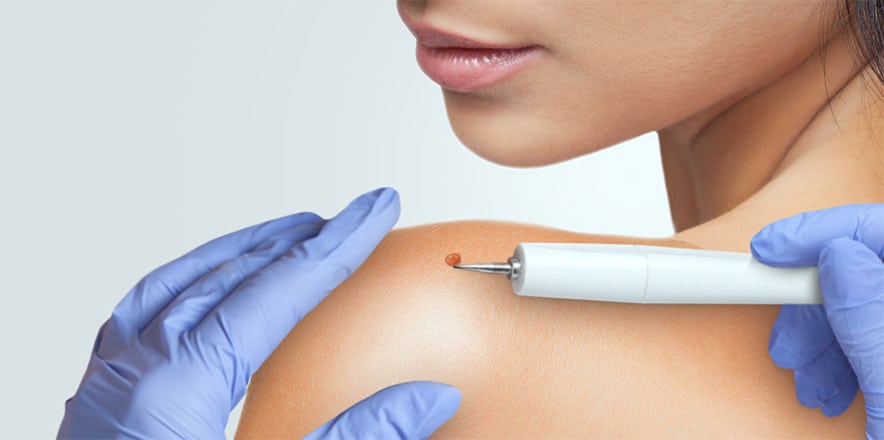Most people have at least a few moles sprinkled over their bodies, and most of the time they are benign and can be ignored for an entire lifetime. However, some moles appear, change shape, or grow over time, and it’s these moles we need to give a little more attention to.
What is a mole?
Moles, also known as nevi, are clusters of skin cells that create skin pigmentation, giving them a darker color than the surrounding skin.
What does a normal mole look like?
Warts are generally painless, though they may be painful if they’re on your feet, due to the additional pressure of standing on them or shoes rubbing them. Some warts will itch. Corns are generally more likely to hurt than warts, as the thickened skin of the corn creates pressure on the nerves and tissues beneath. It may be like having a stone in your shoe. Most moles appear while we are children and may change in appearance or even disappear over time. “Normal” moles are typically round or ovular in shape and brown in color, but can also be black, pink, skin-colored, or even a somewhat blue hue. They are flat or raised and usually less than a quarter of an inch in size. Some moles have a hair or two growing out of them, and this is normal.
What are signs that a mole isn’t normal?
It’s important to get any mole you’re worried has changed in some way looked at by a dermatologist. Most moles are benign, but by having them assessed as soon as you notice that there’s something wrong you can have any suspicious moles removed before they cause a problem.
When assessing whether a mole may be suspicious, follow the 5 signs associated with ABCDE:
- A for asymmetry: Healthy moles are small and circular, but moles that may indicate a melanoma generally have irregular shapes.
- B for border: Healthy moles have a solid border that is defined from the skin around it, but a mole with an uneven border is often worth investigating.
- C for color: Benign moles are usually a solid color, with little or no color differences in the mole. If a mole has several colors in it or has turned darker in color (more black or blueish in hue), ask your dermatologist for mole removal.
- D for diameter: Healthy moles are usually about the size of a pencil eraser, and can be covered easily by the end of your fingertip. Anything larger than this (that isn’t a birthmark) should be checked out.
- E for evolution: Just like any other element of your physical health, moles can change over time, but any significant changes warrant a professional opinion. Moles may change very slowly over a matter of years, but if you’ve noticed a change in weeks or months, ask your dermatologist to assess it for you.
When should I seek mole removal near me?
If you notice any changes that meet one or several of the points above, book an appointment with a dermatologist or your doctor to have it assessed. They’ll be able to tell you if you should have it removed or not. Alternatively, you can choose to have any mole that makes you uncomfortable removed at any time, and if the mole is suspicious a biopsy can be done to ensure there is nothing to worry about.
What is the mole removal procedure like?
There are a few options for mole removal treatment but most dermatologists and doctors will recommend you have any suspicious mole removed to ensure it can’t endanger your good health. There are 4 methods of mole removal:
- Surgical Excision: this is the best choice for large moles and suspicious moles. The area is numbed and your dermatologist will carefully cut the mole out of the skin.
- Shave Removal: this is a good way to get rid of unsightly raised moles or to biopsy a suspicious mole.
- Laser Removal: This is where a laser is used to break down the skin cells in the mole.
- Freezing: Similarly, freezing is used to freeze the unwanted skin cells so they die.
When to See What is the best form of mole removal on the face?
This depends on whether the mole is suspicious or not and if it has a deep base – talk to your dermatologist about any concerns you have and they can help you choose the best method of removal for you.
When to See What is the best When to See a Dermatologist for Mole Removal Treatment
Most people have moles, and those with fair skin are more prone to developing moles during their lifetime. While most moles do not pose a threat to your health, it’s important to have any you believe may have changed checked by a dermatologist. New moles can appear in your adult years, but if it meets any of the ABCDE qualities, make sure you make an appointment with a dermatologist.
If you’re looking for a dermatologist in Los Angeles, Dr. Brian Mekelburg will be happy to see you and perform your mole removal procedure. To find out more about mole removal or to book an appointment for an exam, click here.



